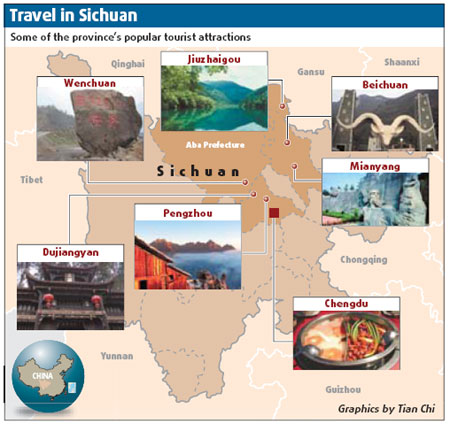
|
CHINA> National
 |
|
Crowds return to quake-hit sites
By Zhang Haizhou (China Daily)
Updated: 2009-02-20 16:51 On the hill overlooking Beichuan, residents sell earthquake souvenirs to those who come each day to gawk at the ruins. Laminated photographs and DVDs with grisly scenes of destruction go for 10 yuan ($1.50), as do sets of incense sticks to burn in memory of the dead. And during the Chinese Lunar New Year, or Spring Festival break, locals said tens of thousands of people had come every day.
 "It's a good thing for us," said Wu Hua, who has sold Qiang ethnic jewelry and knitting decorations since October from one of the huts built by the local authorities last year to house enterprising residents. Dressed in a traditional Qiang overcoat, the 21-year-old said she earned far more than when she was a waitress in a small restaurant that collapsed in the quake.
The cheapest item on her stall is the handmade mobile phone chain, which sells at 5 yuan, while the most expensive ones are traditional Qiang paintings at 50 yuan each. The government says rebuilding a new Beichuan about 35 km to the south will take at least three years. But Wu said that many locals, especially women, would be happy with the current state of affairs "as long as the visitors keep coming here". Beichuan is just one of the sites selected as a memorial to those killed in Sichuan. Donghekou Quake Park, 100 km northeast in Qingchuan County, was opened to the public last November and attracted around 70,000 visitors in the first week after Spring Festival, according to media reports. A tourist agency in Chengdu has also launched a one-day tour of four major quake sites in Pengzhou city, another hard-hit area 40 km northeast. But firms have been urged to show care not to heap further misery on those involved in the disaster. "The fact that more people are coming is proof Sichuan is still beautiful," an anonymous deputy head of the province's tourism administration told China Daily, "but too many visitors will only help in bringing back bad memories for the survivors. Maybe in a couple of years we can promote quake site visits." Xinhua News Agency reported that more than 170,000 visited Sichuan on Feb 7, the first tourism peak after Spring Festival. But an official for the provincial administration said it still needed to make up the massive losses it suffered last year. Although there are still no firm figures on the number of visitors to Sichuan in 2008, he said that the tourism revenue had dropped by more than 20 billion yuan from 2007's total of 121.7 billion yuan. Fewer people came because they thought some of the top destinations were destroyed, he said. |